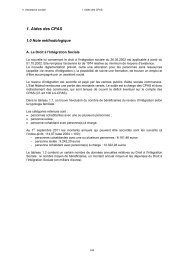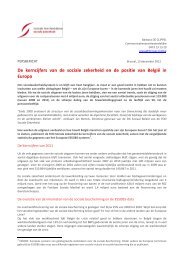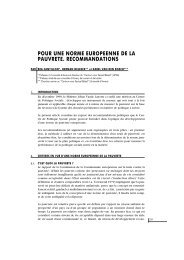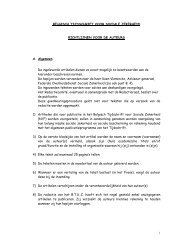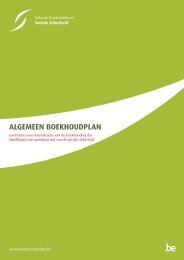social security - FOD Sociale Zekerheid
social security - FOD Sociale Zekerheid
social security - FOD Sociale Zekerheid
- No tags were found...
You also want an ePaper? Increase the reach of your titles
YUMPU automatically turns print PDFs into web optimized ePapers that Google loves.
at new <strong>social</strong> categories (e.g.: the self-employed); on the other hand, the existing benefits(pensions, unemployment benefits and family benefits) were also subject to a positive evolution.This brought along changes in the financing as well: the government's financial input increased.Gradually, our <strong>social</strong> <strong>security</strong> system evolved from a simple insurance against <strong>social</strong> risks toa guarantee for subsistence <strong>security</strong> for everybody. The 1974 law on the subsistence minimum(now <strong>social</strong> integration income) is to be seen in that context.When the crisis hits in the mid-1970s, the unemployment grows, the number of beneficiariesincreases and it gets difficult to contain the costs of <strong>social</strong> <strong>security</strong>. The only solution was toincrease the revenue side and to cut down on <strong>social</strong> benefits. As from 1982, a crisis policy ispursued. Different categories in the unemployment schemes were introduced then. The cut-downin benefits particularly struck couples living together, single persons and young persons duringtheir 'waiting period' (the period before you can receive unemployment benefits).To enhance the competitiveness of companies, the employers' <strong>social</strong> <strong>security</strong> contributions weredrastically lowered over the last few years and partly replaced by 'alternative financing sources'(from VAT revenues).However, as far as the benefits are concerned, minimum pensions have been raised and thelegislations on the '<strong>social</strong> integration income' (the former 'subsistence minimum') and the'income guarantee for the elderly' (the former 'guaranteed income for the aged') have beenchanged. Moreover, since 2008, self-employed persons are also entitled to reimbursements for"small risks".Finally, in 2009, equal treatment for women and men has been completed as to pension age forsalaried persons and self-employed persons. From now on the normal pension age is establishedat 65 years for both men and women.C. Ideological backgroundSocial <strong>security</strong> in the various countries is based on two systems, following the reflections of twopioneers: Bismarck and Beveridge.Bismarck, Germany's Chancellor at the end of the 19th century, elaborated a <strong>social</strong> <strong>security</strong>system in which the financing is borne by both employees and employers, completed with agovernment contribution for pensions. Benefits are salary-linked, for the aim was to guaranteethat all workers could maintain their living standard if particular risks would appear. The Bismarcksystem is a form of solidarity between the workers.Lord Beveridge, who lived in the first half of the 20th century, stated that not only the workers,but also the total population was entitled to subsistence <strong>security</strong>. Regardless of the type ofemployment, he provides - by means of taxes - the same lump sum benefit for every citizen, incase of unemployment, sickness, pension, etc.The Belgian system combines features of both tendencies. For instance, pensions (except for theminimum and maximum amounts) are established through the <strong>social</strong> contributions you havepaid for them (Bismarck), but (almost) everyone is entitled to reimbursement of hospital costs(Beveridge). The <strong>social</strong> assistance systems are to be seen in the light of the Beveridge conceptas well.8



